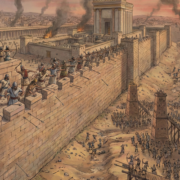Find and Finder of the Month: Yarden Shor discovered an 8th Century CE Arabic inscription

The find chosen for this month was discovered by Yarden Shor, 7 years old, from Jerusalem, who took part in the sifting project towards the end of this summer. She revealed a piece of a marble tile, bearing letters of the Kufic script, which is the earliest form of Arabic, named after the city of Kufa in Iraq. On the basis of a preliminary examination made by Archaeologist Peretz Reuven – who is a member of our research lab team and an expert on the early Islamic period – it appears to be dated to the rule of the Umayyad Dynasty (661-750 CE). It was this dynasty which reconfigured the Temple Mount as an Islamic holy compound and erected its main structures – The Dome of the Rock (691 CE) and the Al-Aqsa Mosque (705 CE). For this reason, it seems appropriate to date the inscription to the end of the 7th Century or the beginning of the 8th Century CE.
Yarden, who discovered the inscription, told us: “When I found the stone, I felt like a young archaeologist, even though I am just now starting 2nd grade. I was happy that I was working together in a group with Grandma and Ofiri and that we found something important”.
Quite by chance, Yarden is the granddaughter of Dr. Pnina Shor, a renown archaeologist who for many years directed the Dead Sea Scrolls department of the Israel Antiquities Authority. However, she and her find were not chosen this month for this reason, but rather because finding an inscription engraved in stone while sifting is far from an everyday occurrence. Artifacts of this type are rare and have yet to make their way to the Temple Mount soil dumps.
Many inscriptions in stone are found on the Temple Mount from the early and later Islamic periods. Some are still found in their original locations, some in secondary use, and others, which were parts of buildings no longer in use, are stored in the warehouses of the Waqf (the Islamic Trust). The overwhelming majority of these inscription have already been documented, researched and published about a century ago by the philologist and epigraphist Max Van Berchem. However, in various Waqf construction debris on the eastern area of the Temple Mount , a number of inscription fragments have been sighted. For some reason the Waqf authorities saw no need to preserve them and they have been left discarded as worthless refuse. This, despite the fact that these are clearly artifacts of the Islamic heritage at this site.
The inscription fragment has yet to be deciphered, and it is doubtful that we will be able to do so on the basis of its few surviving letters. At present, the Temple Mount Sifting Project is overwhelmed with the research of many additional artifacts which have been discovered in years past. Yet, when we get a chance to research this inscription, we will surely share with your its contents.
Discover more from The Temple Mount Sifting Project
Subscribe to get the latest posts sent to your email.












Leave a Reply
Want to join the discussion?Feel free to contribute!